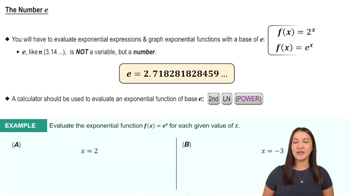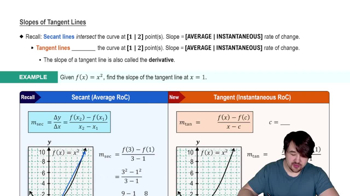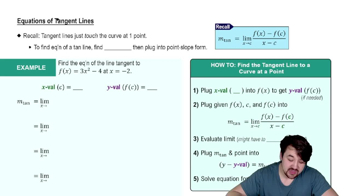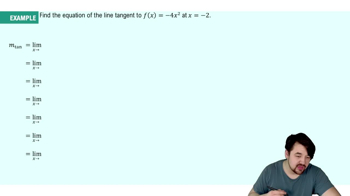Table of contents
- 0. Functions7h 52m
- Introduction to Functions16m
- Piecewise Functions10m
- Properties of Functions9m
- Common Functions1h 8m
- Transformations5m
- Combining Functions27m
- Exponent rules32m
- Exponential Functions28m
- Logarithmic Functions24m
- Properties of Logarithms34m
- Exponential & Logarithmic Equations35m
- Introduction to Trigonometric Functions38m
- Graphs of Trigonometric Functions44m
- Trigonometric Identities47m
- Inverse Trigonometric Functions48m
- 1. Limits and Continuity2h 2m
- 2. Intro to Derivatives1h 33m
- 3. Techniques of Differentiation3h 18m
- 4. Applications of Derivatives2h 38m
- 5. Graphical Applications of Derivatives6h 2m
- 6. Derivatives of Inverse, Exponential, & Logarithmic Functions2h 37m
- 7. Antiderivatives & Indefinite Integrals1h 26m
- 8. Definite Integrals4h 44m
- 9. Graphical Applications of Integrals2h 27m
- 10. Physics Applications of Integrals 2h 22m
2. Intro to Derivatives
Tangent Lines and Derivatives
Problem 99c
Textbook Question
The population of the United States (in millions) by decade is given in the table, where t is the number of years after 1910. These data are plotted and fitted with a smooth curve y = p(t) in the figure. <IMAGE><IMAGE>
Estimate the instantaneous rate of growth in 1985.
 Verified step by step guidance
Verified step by step guidance1
Identify the function y = p(t) that models the population growth. This function is given as a smooth curve fitting the data points from the table.
Determine the year 1985 in terms of t, where t is the number of years after 1910. Calculate t by subtracting 1910 from 1985, which gives t = 75.
To estimate the instantaneous rate of growth at t = 75, you need to find the derivative of the function y = p(t), denoted as p'(t). The derivative represents the rate of change of the population with respect to time.
Evaluate the derivative p'(t) at t = 75. This will give you the instantaneous rate of growth of the population in millions per year at the year 1985.
Interpret the result: The value of p'(75) will indicate how fast the population was growing at that specific year, providing insight into the demographic trends during that period.
 Verified video answer for a similar problem:
Verified video answer for a similar problem:This video solution was recommended by our tutors as helpful for the problem above
Video duration:
4mPlay a video:
Was this helpful?
Key Concepts
Here are the essential concepts you must grasp in order to answer the question correctly.
Instantaneous Rate of Change
The instantaneous rate of change of a function at a given point is defined as the derivative of the function at that point. It represents how the function's output value changes as the input value changes infinitesimally. In the context of population growth, this means calculating the derivative of the population function p(t) at t corresponding to the year 1985.
Recommended video:

Intro To Related Rates
Derivatives
A derivative is a fundamental concept in calculus that measures how a function changes as its input changes. It is often denoted as f'(x) or dp/dt for a function p(t). To estimate the instantaneous rate of growth of the population in 1985, one would need to compute the derivative of the population function p(t) at the specific value of t that represents that year.
Recommended video:

Derivatives
Population Growth Models
Population growth models are mathematical representations that describe how a population changes over time. These models can be linear, exponential, or logistic, depending on the factors influencing growth. Understanding the model used to fit the population data is crucial for accurately estimating the instantaneous rate of growth, as it determines the form of the function p(t) and its derivative.
Recommended video:

The Number e

 5:13m
5:13mWatch next
Master Slopes of Tangent Lines with a bite sized video explanation from Nick
Start learningRelated Videos
Related Practice




